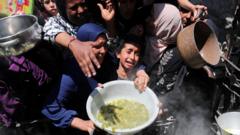The counter-insurgency efforts in central India mark a turning point against the Maoist guerrilla movement.
Dozens of Naxalite Fighters Killed in Major Government Operation in India

Dozens of Naxalite Fighters Killed in Major Government Operation in India
Intensive crackdown on Maoist insurgents leads to significant rebel casualties in Chhattisgarh.
On February 9, 2025, a major operation by government forces in the Bijapur region of Chhattisgarh resulted in the deaths of dozens of Maoist guerrillas, marking one of the most significant confrontations in recent history. The operation targeted the leftist Naxalite movement, which has seen a rise and fall over the years since its inception in the 1960s. Local police chief, Jitendra Kumar Yadav, confirmed that 31 rebels were killed alongside two members of the security forces during the clash.
Amit Shah, India’s home minister, stressed the government's commitment to completely eradicate Naxalism, emphasizing the importance of national security and the safety of citizens from the insurgency. Throughout its history, the Maoist movement has thrived particularly in eastern and central India, with violence reaching alarming levels around 2010, when over 600 civilians and 250 security personnel lost their lives due to the conflict.
More recent government strategies have successfully diminished the number of civilian fatalities and reduced the impact of the insurgents’ activities. The Home Ministry reported a significant drop in violence related to leftist extremism, with 2023 recording an 86% decrease in deaths compared to the peak in 2010. The number of districts affected by this violence has also decreased dramatically, shrinking from 126 to just 38.
Niranjan Sahoo, an expert on left-wing extremism, noted that the Maoists now struggle with member recruitment and have been forced into limited operational areas, such as the Bijapur and Abujhmad forest regions, due to substantial territorial losses. Many analysts now believe that the Naxalite movement is at its most vulnerable point, as ongoing government operations continue to restrict their activities and influence.
Amit Shah, India’s home minister, stressed the government's commitment to completely eradicate Naxalism, emphasizing the importance of national security and the safety of citizens from the insurgency. Throughout its history, the Maoist movement has thrived particularly in eastern and central India, with violence reaching alarming levels around 2010, when over 600 civilians and 250 security personnel lost their lives due to the conflict.
More recent government strategies have successfully diminished the number of civilian fatalities and reduced the impact of the insurgents’ activities. The Home Ministry reported a significant drop in violence related to leftist extremism, with 2023 recording an 86% decrease in deaths compared to the peak in 2010. The number of districts affected by this violence has also decreased dramatically, shrinking from 126 to just 38.
Niranjan Sahoo, an expert on left-wing extremism, noted that the Maoists now struggle with member recruitment and have been forced into limited operational areas, such as the Bijapur and Abujhmad forest regions, due to substantial territorial losses. Many analysts now believe that the Naxalite movement is at its most vulnerable point, as ongoing government operations continue to restrict their activities and influence.






















